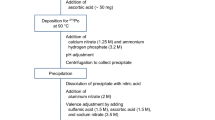Abstract
ICP-MS (inductively coupled plasma mass spectrometry) is shown as a very sensitive method for quantitative determination of Th and U concentration and excretion analysis in urine without any sample pretreatment. The current standard method for incorporation monitoring applies alpha-spectrometry, a very tedious and time consuming technique. ICP-MS offers an attractive alternative for monitoring of thorium and uranium body burdens in occupationally exposed subjects and also larger groups of the general population. A limit of determination of 0.5 ng/L in aqueous solutions and 1 ng/L in urine samples for both elements was achieved, with a precision of about ± 10% in the concentration range of appr. 10 ng/L. Due to the lack of a suitable reference material, the accuracy of the method was tested by comparing some of the results with those obtained by α-spectrometry, especially for U. There was a sufficient agreement on both results.
Similar content being viewed by others
References
H. W. Smith,The Kidney Structure and Function in Health and Disease, Oxford University Press, Oxford, 1964.
H. C. Hodge,Arch. Industr. Health 1956,14, 43
J. H. Wills, in:Pharmacology and Toxicology of Uranium Compounds (B. Voegtlin, H. C. Hodge eds.), McGraw-Hill, New York, 1949.
A. Rothstein, H. Berke,J. Pharmacol. Exp. Ther. 1949,96, 179.
F. Haven, in:Pharmacology and Toxicology of Uranium Compounds (C. Voegtlin, H. C. Hodge, eds.), McGraw-Hill, New York, 1949.
W. B. Mcnider,J. Exp. Med. 1929,49, 411.
T. B. Barnett, R. G. Metcalf, in:Pharmacology and Toxicology of Uranium Compounds (C. Voegtlin, H. C. Hodge eds.), McGraw-Hill, 1949.
J. Bartman,Rev. Belge Path. 1960,27, 307.
C. B. Mueller, A. D. Mason,Surg. Forum 1957,7, 641.
J. Nayman,J. Surg. Res. 1964,4, 82.
A. J. Luessenhop, J. C. Gallimore, W. H. Sweet, E. G. Struxness, J. Robinson,Am. J. Roentgenol. 1958,79, 83.
T. W. Clarkson, J. E. Kench,Biochem. J. 1956,62, 361.
W. Riedel, D. Beyer, A. Dalheimer, H. Doefel, K. Heinrichs, R. SchelerFS-93-69-AKI, 1993.
G. S. Dang, D. D. Jaiswal, C. M. Sunta, S. D. Soman,Health Physics 1989,57, 393.
D. W. Boomer, M. J. Powell,Anal. Chem. 1987,59, 2810.
E. S. Gladney, W. D. Moss, M. A. Gautier, M. G. Bell,Health Physics 1989,57, 171.
P. Allain, S. Berre, A. Premel-Cabic, Y. Mauras,Anal. Chim. Acta 1991,251, 183.
G. S. Hewson, J. J. Fardy,Health Physics 1993,64, 147.
H. Hellmann, U. Kratzel, private communication.
Author information
Authors and Affiliations
Rights and permissions
About this article
Cite this article
Schramel, P., Wendler, I., Roth, P. et al. Method for the determination of thorium and uranium in urine by ICP-MS. Mikrochim Acta 126, 263–266 (1997). https://doi.org/10.1007/BF01242331
Received:
Revised:
Issue Date:
DOI: https://doi.org/10.1007/BF01242331




